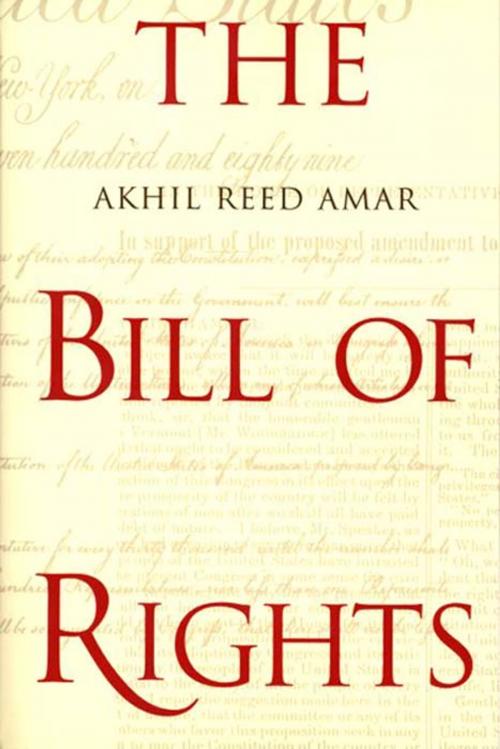| Author: | Professor Akhil Reed Amar | ISBN: | 9780300127089 |
| Publisher: | Yale University Press | Publication: | October 1, 2008 |
| Imprint: | Yale University Press | Language: | English |
| Author: | Professor Akhil Reed Amar |
| ISBN: | 9780300127089 |
| Publisher: | Yale University Press |
| Publication: | October 1, 2008 |
| Imprint: | Yale University Press |
| Language: | English |
Are the deep insights of Hugo Black, William Brennan, and Felix Frankfurter that have defined our cherished Bill of Rights fatally flawed? With meticulous historical scholarship and elegant legal interpretation a leading scholar of Constitutional law boldly answers yes as he explodes conventional wisdom about the first ten amendments to the U.S. Constitution in this incisive new account of our most basic charter of liberty. Akhil Reed Amar brilliantly illuminates in rich detail not simply the text, structure, and history of individual clauses of the 1789 Bill, but their intended relationships to each other and to other constitutional provisions. Amar's corrective does not end there, however, for as his powerful narrative proves, a later generation of antislavery activists profoundly changed the meaning of the Bill in the Reconstruction era. With the Fourteenth Amendment, Americans underwent a new birth of freedom that transformed the old Bill of Rights.
We have as a result a complex historical document originally designed to protect the people against self-interested government and revised by the Fourteenth Amendment to guard minority against majority. In our continuing battles over freedom of religion and expression, arms bearing, privacy, states' rights, and popular sovereignty, Amar concludes, we must hearken to both the Founding Fathers who created the Bill and their sons and daughters who reconstructed it.
Amar's landmark work invites citizens to a deeper understanding of their Bill of Rights and will set the basic terms of debate about it for modern lawyers, jurists, and historians for years to come.
We have as a result a complex historical document originally designed to protect the people against self-interested government and revised by the Fourteenth Amendment to guard minority against majority. In our continuing battles over freedom of religion and expression, arms bearing, privacy, states' rights, and popular sovereignty, Amar concludes, we must hearken to both the Founding Fathers who created the Bill and their sons and daughters who reconstructed it.
Amar's landmark work invites citizens to a deeper understanding of their Bill of Rights and will set the basic terms of debate about it for modern lawyers, jurists, and historians for years to come.
Are the deep insights of Hugo Black, William Brennan, and Felix Frankfurter that have defined our cherished Bill of Rights fatally flawed? With meticulous historical scholarship and elegant legal interpretation a leading scholar of Constitutional law boldly answers yes as he explodes conventional wisdom about the first ten amendments to the U.S. Constitution in this incisive new account of our most basic charter of liberty. Akhil Reed Amar brilliantly illuminates in rich detail not simply the text, structure, and history of individual clauses of the 1789 Bill, but their intended relationships to each other and to other constitutional provisions. Amar's corrective does not end there, however, for as his powerful narrative proves, a later generation of antislavery activists profoundly changed the meaning of the Bill in the Reconstruction era. With the Fourteenth Amendment, Americans underwent a new birth of freedom that transformed the old Bill of Rights.
We have as a result a complex historical document originally designed to protect the people against self-interested government and revised by the Fourteenth Amendment to guard minority against majority. In our continuing battles over freedom of religion and expression, arms bearing, privacy, states' rights, and popular sovereignty, Amar concludes, we must hearken to both the Founding Fathers who created the Bill and their sons and daughters who reconstructed it.
Amar's landmark work invites citizens to a deeper understanding of their Bill of Rights and will set the basic terms of debate about it for modern lawyers, jurists, and historians for years to come.
We have as a result a complex historical document originally designed to protect the people against self-interested government and revised by the Fourteenth Amendment to guard minority against majority. In our continuing battles over freedom of religion and expression, arms bearing, privacy, states' rights, and popular sovereignty, Amar concludes, we must hearken to both the Founding Fathers who created the Bill and their sons and daughters who reconstructed it.
Amar's landmark work invites citizens to a deeper understanding of their Bill of Rights and will set the basic terms of debate about it for modern lawyers, jurists, and historians for years to come.















